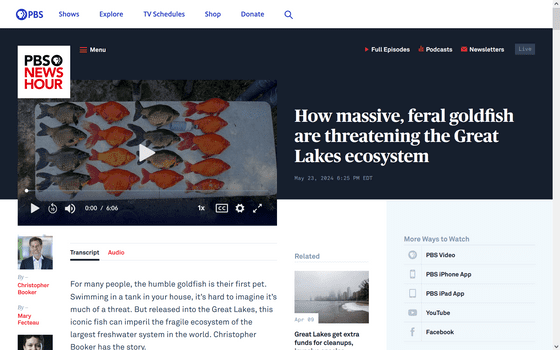How giant wild goldfish are threatening the Great Lakes ecosystem

Goldfish that were originally bought as pets have become wild and are living in
How massive, feral goldfish are threatening the Great Lakes ecosystem | PBS NewsHour
https://www.pbs.org/newshour/show/how-massive-feral-goldfish-are-threatening-the-great-lakes-ecosystem

Booker interviewed ecologist Andrea Cote, who manages the ecosystem in

Since the fishway was opened in 1997, carp have been a nuisance to the caretakers, but over the 10 years leading up to 2024, the carp population has decreased and goldfish have begun to breed instead.
'The goldfish population started increasing around 2013,' said Court, expressing concern that goldfish, like carp, could pose a threat to the ecosystem.
Goldfish are known for their bright orange color and are small enough to fit into a fishbowl the size of a human head. However, wild goldfish turn darker for camouflage and grow larger by eating an almost limitless supply of food. According to John Midwood, a researcher at the Great Lakes Fisheries and Aquatic Sciences Institute, the world's largest goldfish can reach 9 pounds (about 4 kg).
'We estimate that there are tens of millions of wild goldfish in the Great Lakes alone, and it's highly likely that they were brought in from ordinary households,' Midwood said, adding that the goldfish were likely bought from pet stores or somewhere else, released and then became feral.
According to Midwood, goldfish not only compete with native species for food, but also stir up the sediments in the lake, making it murky. 'Goldfish are one of the most problematic fish in aquatic systems,' Midwood said. 'There are other aquatic invasive species, but I think goldfish are going to have the greatest impact on our goal of restoring aquatic vegetation in the near future.'

'Once an aquatic invasive species gets into a water system, there's nothing we can do but try to reduce their numbers, so prevention is the best option,' Midwood said.
Goldfish can also live for up to 30 to 40 years, which makes them difficult to care for in an average household.
In an effort to prevent irresponsible releases, the Erie Zoo , located near Lake Erie , one of the Great Lakes, is starting a project in 2023 to collect unwanted fish.
The project being carried out by the Erie Zoo is called the ' Last Chance Lagoon .' The Erie Zoo has prepared a 23,000-gallon (about 87,000 liters) aquarium in the center of the zoo, where they are keeping goldfish and koi that have been given up by members of the public. Some owners mistakenly believe that releasing goldfish and koi into their natural habitat is a 'kind act,' so the zoo is carrying out this activity to prevent environmental destruction based on this belief.
'The primary goal of this project is to educate the public about invasive species, which are a big problem in the Great Lakes, how to properly care for pets and how they thrive,' said Heather Gura of the Erie Zoo. 'We've had a lot of people these days who want exotic pets or bring in pets they don't know how to take care of.'
Related Posts:
in Creature, Posted by log1p_kr







